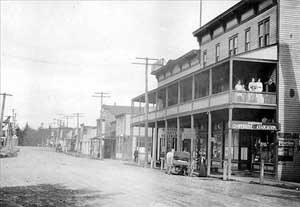On August 23, 1927, the Marysville-Everett cutoff opens. This roadway (part of the Pacific Highway and later designated SR 529) shortens the distance between Marysville and Everett from nearly 11 miles to four miles, and marks a significant milestone for transportation in Snohomish County. Gala celebrations to mark the occasion are held in both cities, especially in Marysville, where the road will have the greatest impact.
Talk of Saving Time
Almost from the time the town of Marysville was platted in 1885, there was talk of building a direct route over the sloughs separating Marysville from Everett. It would be a tremendous time saver in comparison to the existing route. Until 1927 the road from Marysville to Everett was a nearly 11-mile trek which dipped well east and south of Marysville, following what was known as the “Sunnyside route” (today’s [2007] Sunnyside Boulevard), to Cavalero Corner (where today Sunnyside Boulevard and Highway 2 meet), then taking a hard turn to the west into downtown Everett.
There was talk of building a shorter route between Marysville and Everett for a number of years, but no action was taken until the early 1920s, when the Washington State Legislature appropriated $30,000 to survey a route. By this time the Pacific Highway, running from the Canadian border to the Mexican border, was coming together. Since this highway ran through both Marysville and Everett, and since technological progress by the 1920s was rapidly making transportation both easier and more widespread, building the cutoff assumed a much greater urgency. Bridges across the delta between Marysville and Everett were built and more plans were made for the roadway itself.
Paving the Pacific Highway
Bids were finally taken for the paving portion of the project on April 12, 1927, with the contract going to the Norris Brothers. It was initially hoped that paving would begin by late April, but delays pushed the start back by nearly a month. Finally, concrete was laid in Marysville on May 24 and, moving south, on the north end of the cutoff outside of the town on May 30. Work proceeded smoothly from there. By June 2 the contractors had crossed the Ebey Slough Bridge and, paving at the rate of about 400 feet a day, reached the bridge over Steamboat Slough on June 12. At that point the Norris Brothers moved their base of operations from Marysville to Everett, paving a small segment in Everett itself before crossing the Snohomish River Bridge at the northern end of the town and moving north across the bridge over Union Slough and eventually reaching the bridge over Steamboat Slough. Work was completed late on July 23, eight days ahead of schedule, at a cost of $1,250,000.
At that point, the focus shifted to making plans for a big celebration to “celebrate the opening of the final link in the famous Pacific Highway,” crowed the Marysville Globe on July 14, 1927. The state required 30 days for the newly laid concrete to cure, and thus Tuesday, August 23, was chosen as the big day. Big plans were laid; big names were invited to speak; there was the inevitable infighting and squabbling as various dignitaries and pseudo-dignitaries alike vied for the choicest assignments.
But everything came together for Dedication Day. Virtually all of the scheduled speakers showed, the weather was perfect, and at 10 a.m. on August 23, a mile-long parade formed in Everett at the Elks Club. Led by the Elks Club, the parade proceeded to Broadway Street and headed north, onto the new cutoff and across the four bridges leading to Marysville. (This route is today Washington State Route 529). A ribbon stretched across the northern end of the final bridge (the Ebey Slough Bridge) briefly stopped the procession at the southern edge of Marysville, whereupon Governor Roland Hartley (1864-1952) regally alighted from his automobile, ceremoniously cut the ribbon and gave a brief talk. As he finished, fireworks exploded overhead, the Marysville mill whistles and siren shrilled, and the procession proceeded to the Marysville City Park for the festivities.
Here Comes Marysville
Nearly 2,000 people -- virtually all of Marysville’s 1927 population and then some -- crowded into the city park for the occasion (the Seattle Post-Intelligencer reported the next day that a total of 5,000 had participated in the ceremonies in both Everett and Marysville). Announcer James Stryker, sporting a 10-gallon hat, kicked off the ceremonies, carrier pigeons were released to carry messages (with the assistance of the Seattle postmaster) to the governors of Oregon and California as well as to Queen Marie of Romania, the Marysville Band played a marching tune, and the 13 scheduled speakers spoke.
It was a relaxed, joyous affair: “The program was very informal, the atmosphere was informal, the speakers spoke genially, jokingly, and easily” (Seattle Post-Intelligencer, August 24, 1927, p. 3). One of the more noteworthy speakers was Samuel Hill (1857-1931), who gave the dedicatory address. Hill, founder of the Washington State Good Roads Association and a driving force behind the construction of the Pacific Highway, “paid high tribute to the men who made pavement out of visions” (The Marysville Globe, August 25, 1927, p. 1). The festivities continued in Marysville for the entire day and ended that evening with a pavement dance.
The cutoff’s importance cannot be overstated. It didn’t improve travel just between Marysville and Everett. It also improved travel on the Pacific Highway between Seattle and points north -- for example, the cutoff reduced travel time by bus between Seattle and Bellingham from just over four hours to three and a half hours. The cutoff represented a milestone in the construction of good roads during the 1920s and was a tremendous economic benefit to Marysville as well -- new buildings were built, new businesses sprang up, traffic at existing businesses increased, and overall growth in the town accelerated, all thanks to the cutoff.

